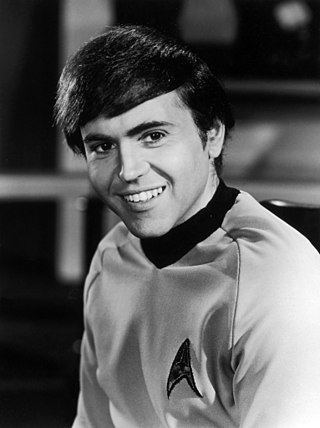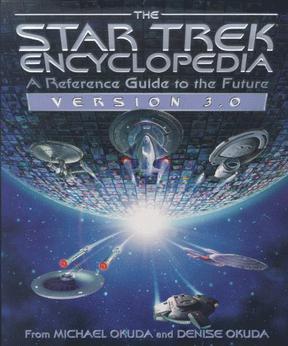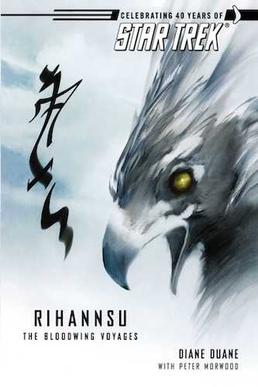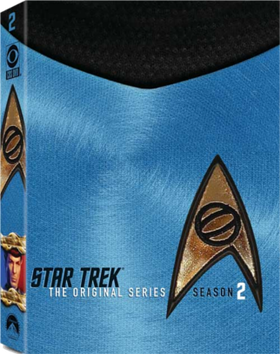Star Trek is an American science fiction television series created by Gene Roddenberry that follows the adventures of the starship USS Enterprise (NCC-1701) and its crew. It later acquired the retronym of Star Trek: The Original Series (TOS) to distinguish the show within the media franchise that it began.

Star Trek: The Animated Series (TAS), is an American animated science fiction television series created by Gene Roddenberry. It originally aired under the title simply as Star Trek, subtitled Created by Gene Roddenberry, on Saturday mornings from September 8, 1973, to October 12, 1974, on NBC, spanning 22 episodes over two seasons. The second series in the Star Trek franchise, it features mostly the same characters as Star Trek: The Original Series. Set in the 23rd century, when Earth is part of a United Federation of Planets, it follows the adventures of the Starfleet vessel USS Enterprise as it explores the Milky Way galaxy.

Pavel Andreievich Chekov is a fictional character in the Star Trek universe.
A stardate is a fictional system of time measurement developed for the television and film series Star Trek. In the series, use of this date system is commonly heard at the beginning of a voice-over log entry, such as "Captain's log, stardate 41153.7. Our destination is planet Deneb IV …". While the original method was inspired by the Modified Julian date system currently used by astronomers, writers and producers have selected numbers using different methods over the years, some more arbitrary than others. This makes it impossible to convert all stardates into equivalent calendar dates, especially since stardates were originally intended to avoid specifying exactly when Star Trek takes place.

The Star Trek Encyclopedia: A Reference Guide to the Future is a 1994 encyclopedia of in-universe information from the Star Trek television series and films. It was written by Michael Okuda and Denise Okuda, who were production staff on Star Trek: The Next Generation, Star Trek: Deep Space Nine and Star Trek: Voyager and Debbie Mirek. It was illustrated by Doug Drexler.
This article discusses the fictional timeline of the Star Trek franchise. The franchise is primarily set in the future, ranging from the mid-22nd century to the early 25th century. However the franchise has also outlined a fictional future history of Earth prior to this, and, primarily through time travel plots, explored both past and further-future settings, including the third season onwards of Star Trek: Discovery being set in the 32nd century.
"The Infinite Vulcan" is the seventh episode of the first season of the American animated science fiction television series Star Trek: The Animated Series. It first aired on NBC on October 20, 1973, and was written by Original Series cast member Walter Koenig. It was the actor's only involvement in the series, as he had not been hired to voice Pavel Chekov in the animated version due to budgetary limitations. With "The Infinite Vulcan", Koenig became the first member of the Star Trek cast to write an episode for the franchise. As with the rest of the first season, the episode was directed by Hal Sutherland.

Star Trek: Rihannsu is a series of interlinked novels, written by Diane Duane and Peter Morwood, published by Pocket Books from 1984 to 2006. The series name was retroactively applied to the first novels with the release of new installments in 2000. A fifth novel was published in 2006.

Dorothy Catherine Fontana was an American television script writer and story editor, best known for her work on the original Star Trek series and several Western television series.
Betty JoAnne Trimble, known as Bjo, is an American science fiction fan and writer, initially entering fandom in the early 1950s.
The Star Trek canon is the set of all canonical material in the Star Trek universe. The official Star Trek website uses the term canon to refer to the various elements present in the television series and feature films of the franchise.
Dorothy Jones Heydt (1942-2022) was a United States author of science fiction and fantasy. She lived on the U.S. West Coast and was an active participant in the Usenet newsgroups rec.arts.sf.written and rec.arts.sf.fandom, and in science fiction fandom in general. She was the originator of the "Eight Deadly Words", and other fan quotes. She was the originator and first editor of the Star Trek Concordance, an extensive resource guide first published in March 1969.

A Trekkie or Trekker is a fan of the Star Trek franchise, or of specific television series or films within that franchise.

The first season of the American science-fiction television series Star Trek, originally created by Gene Roddenberry, premiered on NBC on September 8, 1966, and concluded on April 13, 1967. The season debuted in Canada on CTV two days before the US premiere, on September 6, 1966. It consisted of 29 episodes, which is the highest number of episodes in a season for the original series of Star Trek. It features William Shatner as Captain James T. Kirk, Leonard Nimoy as Spock, and DeForest Kelley as Leonard McCoy.

The second season of the American science fiction television series Star Trek, premiered on NBC on September 15, 1967 and concluded on March 29, 1968. It consisted of twenty-six episodes. It features William Shatner as Captain James T. Kirk, Leonard Nimoy as Spock and DeForest Kelley as Leonard McCoy.

The third and final season of the American science fiction television series Star Trek, premiered on NBC on Friday, September 20, 1968 and concluded on Tuesday, June 3, 1969. It consisted of twenty-four episodes. Star Trek: The Original Series is an American science fiction television series produced by Fred Freiberger, and created by Gene Roddenberry, and the original series of the Star Trek franchise. It features William Shatner as Captain James T. Kirk, Leonard Nimoy as Spock and DeForest Kelley as Leonard McCoy.
These Are the Voyages is a six-volume non-fiction reference book series by Marc Cushman with Susan Osborn about Star Trek: The Original Series and the subsequent movies/television in the 1970s, published by Jacobs Brown Press. The information revealed inside primarily comes from production documents that were donated by Star Trek creator/producer Gene Roddenberry and show co-producer Robert H. Justman to the UCLA Film and Television Archive.
Lincoln Enterprises, formerly Star Trek Enterprises, was a mail-order company set up by Bjo Trimble and Gene Roddenberry to sell merchandise related to the American science fiction television series Star Trek. It was known for selling official scripts and film cells directly from Desilu Productions during the run of the series. It later expanded into general Star Trek merchandise under Majel Barrett, and has since subsumed into Roddenberry.com.









